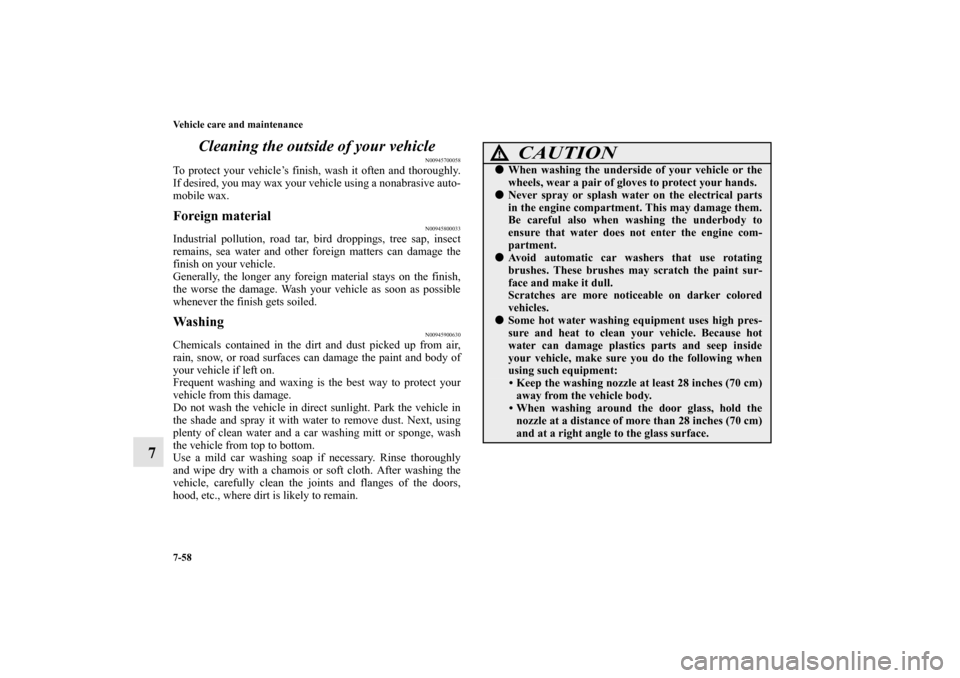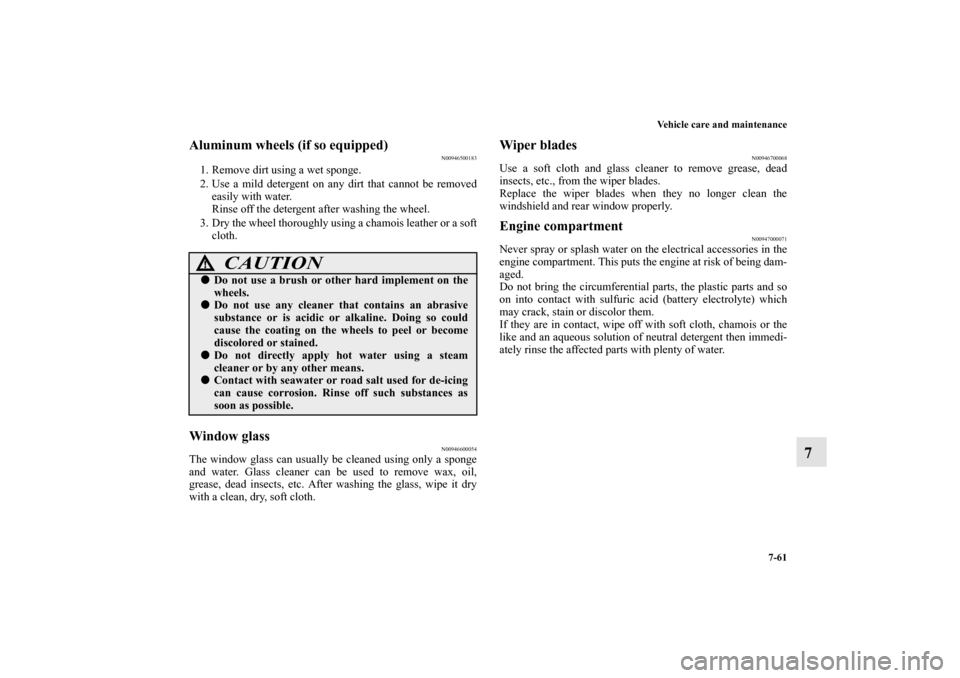Page 415 of 460
Vehicle care and maintenance
7-41
7
Fuse replacement
N00954900131
1. Before replacing a fuse, always turn off the electrical item
concerned to the fuse and turn the ignition switch to the
“OFF” position or put the operation mode in OFF.
2. There is a fuse remover (A) in the engine compartment
fuse block.3. Clamp it on the fuse you wish to remove, and pull the fuse
straight out from the fuse block.
BK0162600US.book 41 ページ 2013年3月22日 金曜日 午後2時41分
Page 432 of 460

7-58 Vehicle care and maintenance
7Cleaning the outside of your vehicle
N00945700058
To protect your vehicle’s finish, wash it often and thoroughly.
If desired, you may wax your vehicle using a nonabrasive auto-
mobile wax.Foreign material
N00945800033
Industrial pollution, road tar, bird droppings, tree sap, insect
remains, sea water and other foreign matters can damage the
finish on your vehicle.
Generally, the longer any foreign material stays on the finish,
the worse the damage. Wash your vehicle as soon as possible
whenever the finish gets soiled.Wa s h i n g
N00945900630
Chemicals contained in the dirt and dust picked up from air,
rain, snow, or road surfaces can damage the paint and body of
your vehicle if left on.
Frequent washing and waxing is the best way to protect your
vehicle from this damage.
Do not wash the vehicle in direct sunlight. Park the vehicle in
the shade and spray it with water to remove dust. Next, using
plenty of clean water and a car washing mitt or sponge, wash
the vehicle from top to bottom.
Use a mild car washing soap if necessary. Rinse thoroughly
and wipe dry with a chamois or soft cloth. After washing the
vehicle, carefully clean the joints and flanges of the doors,
hood, etc., where dirt is likely to remain.
CAUTION
!�When washing the underside of your vehicle or the
wheels, wear a pair of gloves to protect your hands.�Never spray or splash water on the electrical parts
in the engine compartment. This may damage them.
Be careful also when washing the underbody to
ensure that water does not enter the engine com-
partment.�Avoid automatic car washers that use rotating
brushes. These brushes may scratch the paint sur-
face and make it dull.
Scratches are more noticeable on darker colored
vehicles.�Some hot water washing equipment uses high pres-
sure and heat to clean your vehicle. Because hot
water can damage plastics parts and seep inside
your vehicle, make sure you do the following when
using such equipment:
• Keep the washing nozzle at least 28 inches (70 cm)
away from the vehicle body.
• When washing around the door glass, hold the
nozzle at a distance of more than 28 inches (70 cm)
and at a right angle to the glass surface.
BK0162600US.book 58 ページ 2013年3月22日 金曜日 午後2時41分
Page 434 of 460

7-60 Vehicle care and maintenance
7
Polishing
N00946100046
If painted surfaces have been severely damaged and lost their
original luster and color tone, polish the surface lightly with a
fine polishing compound. Avoid limiting your polishing to the
damaged surface only; polish a somewhat wider area, moving
the polishing cloth in one direction. After polishing, flush the
compound from the surface and apply a coat of wax to regain a
beautiful luster.Damaged paint
N00946200092
Small cracks and scratches in the paint coat should be touched
up as soon as possible with touch-up paint to prevent corrosion.
Check body areas facing the road or the tires carefully for dam-
age to the paint caused by flying stones, etc. The paint code
number for your vehicle can be found on the vehicle informa-
tion code plate on the front passenger door sill.
Cleaning plastic parts
N00946300194
Use a sponge or chamois to clean these parts.
If a vehicle wax sticks to a gray or black rough surface of the
bumper, molding or lights, the surface may appear white in
color. In this case, wipe it off using lukewarm water and a soft
cloth or chamois.Chrome parts
N00946400052
To prevent spots and corrosion of chrome parts, wash with
water, dry thoroughly, and apply a nonabrasive automotive
wax. If the chrome is severely damaged or pitted, use a com-
mercially available chrome polish.
CAUTION
!�Do not use a scrubbing brush or other rough scrub-
ber as these may damage the plastic surface.�Do not use wax containing compounds (polishing
powder) which may damage the plastic surface.�Do not let plastic parts get soiled with gasoline, oil,
brake fluids, engine oils, greases, paint thinner, and
sulfuric acid (battery electrolyte), as such substances
will cause stains, cracks, or discoloration.
If any of these get on a plastic part, wipe them up
with a soft cloth or chamois and a mild solution of
soap and water. Then rinse them immediately with
water.
BK0162600US.book 60 ページ 2013年3月22日 金曜日 午後2時41分
Page 435 of 460

Vehicle care and maintenance
7-61
7
Aluminum wheels (if so equipped)
N00946500183
1. Remove dirt using a wet sponge.
2. Use a mild detergent on any dirt that cannot be removed
easily with water.
Rinse off the detergent after washing the wheel.
3. Dry the wheel thoroughly using a chamois leather or a soft
cloth.Window glass
N00946600054
The window glass can usually be cleaned using only a sponge
and water. Glass cleaner can be used to remove wax, oil,
grease, dead insects, etc. After washing the glass, wipe it dry
with a clean, dry, soft cloth.
Wiper blades
N00946700068
Use a soft cloth and glass cleaner to remove grease, dead
insects, etc., from the wiper blades.
Replace the wiper blades when they no longer clean the
windshield and rear window properly.Engine compartment
N00947000071
Never spray or splash water on the electrical accessories in the
engine compartment. This puts the engine at risk of being dam-
aged.
Do not bring the circumferential parts, the plastic parts and so
on into contact with sulfuric acid (battery electrolyte) which
may crack, stain or discolor them.
If they are in contact, wipe off with soft cloth, chamois or the
like and an aqueous solution of neutral detergent then immedi-
ately rinse the affected parts with plenty of water.
CAUTION
!�Do not use a brush or other hard implement on the
wheels.�Do not use any cleaner that contains an abrasive
substance or is acidic or alkaline. Doing so could
cause the coating on the wheels to peel or become
discolored or stained.�Do not directly apply hot water using a steam
cleaner or by any other means.�Contact with seawater or road salt used for de-icing
can cause corrosion. Rinse off such substances as
soon as possible.
BK0162600US.book 61 ページ 2013年3月22日 金曜日 午後2時41分
Page 443 of 460
9
Specifications
Vehicle labeling . . . . . . . . . . . . . . . . . . . . . . . . . . .9- 2
Vehicle dimensions . . . . . . . . . . . . . . . . . . . . . . . .9- 5
Vehicle weights . . . . . . . . . . . . . . . . . . . . . . . . . . .9- 6
Engine specifications . . . . . . . . . . . . . . . . . . . . . . .9- 7
Battery . . . . . . . . . . . . . . . . . . . . . . . . . . . . . . . . . .9- 8
Tires and wheels. . . . . . . . . . . . . . . . . . . . . . . . . . .9- 8
Capacity . . . . . . . . . . . . . . . . . . . . . . . . . . . . . . . . .9- 9
BK0162600US.book 1 ページ 2013年3月22日 金曜日 午後2時41分
Page 444 of 460
9-2 Specifications
9Vehicle labeling
N01147400742
Keep a record of the chassis number and vehicle identification
number. Such information will assist police if your vehicle is
stolen.1 - Vehicle emission control information labelThe vehicle emission control information label is affixed on the
underside of the engine hood.2 - Vehicle identification number plateThe vehicle identification number is stamped on the plate riv-
eted to the left front corner of the vehicle body. It is visible
from outside of the vehicle through the windshield.3 - Air conditioning labelThe air conditioning label is affixed on the inside panel of the
engine hood.
4 - Vehicle information code plateThe vehicle information code plate is located on the front pas-
senger door sill.
BK0162600US.book 2 ページ 2013年3月22日 金曜日 午後2時41分
Page 445 of 460
Specifications
9-3
9
Chassis numberThe chassis number is stamped on the bulkhead as shown in
the illustration.
Engine serial numberThe engine serial number is stamped on the cylinder block as
shown in the illustration.*- Front of the vehicle
BK0162600US.book 3 ページ 2013年3月22日 金曜日 午後2時41分
Page 449 of 460
Specifications
9-7
9 Engine specifications
N01147700514
Engine model3A92Engine displacement
72.8 CID (1,193 cm
3)
No. of cylinders and cylinder arrangement Inline-3Bore2.95 in (75.0 mm)Stroke3.54 in (90.0 mm)Compression ratio10.5:1Thermostat valve opening temperature 189 °F (87 °C)Spark plugs
NGK LZFR5BI-11
Spark plug gap .040 to .043 in (1.0 to 1.1 mm)Firing order1-3-2
BK0162600US.book 7 ページ 2013年3月22日 金曜日 午後2時41分